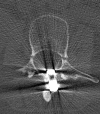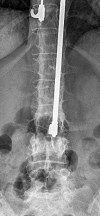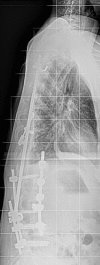Spontaneus bilateral pedicle fracture 30 years after Harrington Instrumentation for idiopathic scoliosis: a case report
- PMID: 22269652
- PMCID: PMC3281785
- DOI: 10.1186/1752-1947-6-29
Spontaneus bilateral pedicle fracture 30 years after Harrington Instrumentation for idiopathic scoliosis: a case report
Abstract
Introduction: Spontaneous fractures of the spine are a common entity. They usually occur in older people with osteoporosis. This case is presented on account of its rarity. To the best of the authors' knowledge only one case of an osteoporotic pedicle fracture after Harrington Instrumentation has been described before.
Case presentation: We report the case of a 46-year-old Caucasian woman who underwent surgery due to idiopathic scoliosis with a Harrington Instrumentation (T4 to L3) 30 years ago. During the operation she was infected with hepatitis C while receiving erythrocyte concentrates and has suffered from liver cirrhosis since then. She presented with a sudden pain in her lower back and paraesthesia in both her legs but no other neurological symptoms. A computed tomography scan showed a bilateral pedicle fracture of L3 and an additional compression fracture of L4. In the first session we performed a dorsal stabilization with massive intraoperative bleeding and a postoperative failure of liver synthesis. In a second session an additional ventral augmentation was done. After the second operation she developed a hepatorenal syndrome. Both operations left the patient in a very critical state which led to a prolonged stay in the intensive care and rehabilitation unit. At her 12-month follow-up visit, she was free of complaints.
Conclusion: The un-physiological load of the spine after Harrington Instrumentation can lead to osteoporosis due to inactivity even in younger patients. Although these implants are not used anymore one should keep this possibility in mind when dealing with patients who have received Harrington rods in surgical procedures.
Figures







Similar articles
-
Late Fracture After Long Spinal Fusion for Idiopathic Scoliosis: A Case Report.Spine Deform. 2015 May;3(3):277-280. doi: 10.1016/j.jspd.2014.11.002. Epub 2015 Apr 23. Spine Deform. 2015. PMID: 27927471
-
Bilateral pedicle stress fracture in a patient with osteoporotic compression fracture.Eur Spine J. 2009 Jul;18 Suppl 2(Suppl 2):206-9. doi: 10.1007/s00586-008-0816-5. Epub 2008 Nov 13. Eur Spine J. 2009. PMID: 19005693 Free PMC article.
-
Compression fracture in the middle of a chronic instrumented fusion that developed into pseudarthrosis after balloon kyphoplasty.J Neurosurg Spine. 2014 Jun;20(6):705-8. doi: 10.3171/2014.2.SPINE13799. Epub 2014 Mar 28. J Neurosurg Spine. 2014. PMID: 24678664
-
Radicular pain after Harrington instrumentation.J Spinal Disord. 1989 Mar;2(1):1-5. J Spinal Disord. 1989. PMID: 2520054 Review.
-
Mid- to long-term outcomes in adolescent idiopathic scoliosis after instrumented posterior spinal fusion: a meta-analysis.Spine (Phila Pa 1976). 2013 Jan 15;38(2):E113-9. doi: 10.1097/BRS.0b013e31827ae3d0. Spine (Phila Pa 1976). 2013. PMID: 23124268 Review.
Cited by
-
Can posterior implant removal prevent device-related vertebral osteopenia after posterior fusion in adolescent idiopathic scoliosis? A mean 29-year follow-up study.Eur Spine J. 2019 Jun;28(6):1314-1321. doi: 10.1007/s00586-019-05921-6. Epub 2019 Feb 19. Eur Spine J. 2019. PMID: 30783802
References
-
- Halm H, Richter A, Thomsen B, Köszegvary M, Ahrens M, Quante M. Anterior scoliosis surgery. State of the art and a comparison with posterior techniques. Orthopäde. 2009;38:131–134, 136-140, 142-145. - PubMed
-
- Wibaux C, Legroux-Gerot I, Dharancy S, Boleslwaski E, Declerck N, Canva V, Mathurin P, Pruvot FR, Cortet B. Assesing bone status in patients awaiting liver transplantation. Joint Bone Spine. 2011;78:367–391. - PubMed
LinkOut - more resources
Full Text Sources

